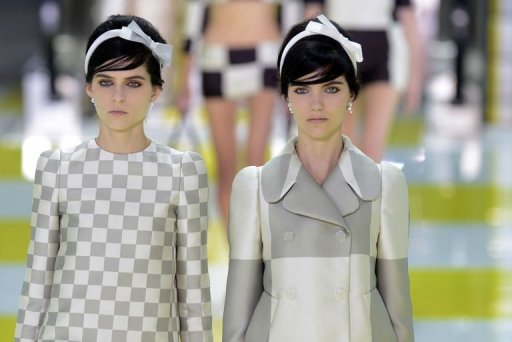 AFP – Two by two, Louis Vuitton’s models glided down a row of elevators on to a giant checked runway, as designer Marc Jacobs unveiled Wednesday a look fed by conceptual art and the house’s 125-year-old damier motif.
AFP – Two by two, Louis Vuitton’s models glided down a row of elevators on to a giant checked runway, as designer Marc Jacobs unveiled Wednesday a look fed by conceptual art and the house’s 125-year-old damier motif.
For his spring-summer line, unveiled in the courtyard of the Louvre on the final day of Paris Fashion Week, Jacobs cited as chief inspiration Daniel Buren, a French contemporary artist who helped him created the set for the show.
“His work is very graphic but it always moves me,” the designer told reporters after the show, which was a clean break with the French house’s recent lyrical outings that have featured a life-sized train or a twirling carousel.
“After the romance of the train and storytelling, this felt like something that was very powerful without really having a story,” said the New Yorker, who has worked in the past with artists including Japan’s Takashi Murakami.
Buren is best known for a group of 260 columns of varying heights set on a black-and-white grid that have stood since 1986 in the Palais Royal gardens a stone’s throw from the Louvre, and which directly influenced the show.
In sartorial terms, Buren’s aesthetic translated into linear silhouettes — “a perpendicular block” cut at three levels: short, mid-calf or long.
“It’s very straight and the the only curve is the sleeve and that’s that,” said Jacobs.
For the first time, he eliminated the house’s “LV” monogram, replacing it with a check which both references Buren’s work and the Louis Vuitton damier, which the firm trademarked as a signature pattern in 1888.
These checks defined the look as the models floated down the escalators, on to a giant white and yellow grid, each duo in matching colours but with a varying cut and pattern — long and short, or positive and negative.
Buren has also produced art installations using escalators, and Jacobs said he was inspired by “this very soothing motion of this graphic pattern as it pours down this mechanical thing”.
“It’s a moving pattern, it’s a rhythm and a pattern and it’s a mathematical equation, it just continues and just creates a constant change.”
So a pair of milk chocolate and white checked brassieres over long tubular skirts, for instance, came with small squares on the skimpy brassiere, and a larger one for the more demure model.
Necklines were round, straight across the collarbones or the chest, with short bouffant hair tamed under a thin headband, and little bags that picked up generously on the check motif.
Jacobs opened with a dozen sets of checks, on floor-length skirts, pantsuits, skimpy skirts and little jackets buttoned at the neck and parted over bare skin, in black, moss green, lemon yellow or soft maroon set against white.
Then came pairs of dresses and suits with an abstract Japanese-inspired foliage motif, in long and short version, or as mirror images like a knee-length dress in green on white, and white on green.
For evening time, the same cuts, in checks or plain black and white, but with a metallic shimmer created using thousands of sequins — the smallest ever produced according to Jacobs.
“I don’t know if it looks modern, like what’s modern?” the designer asked the mob of reporters pressing around him backstage.
